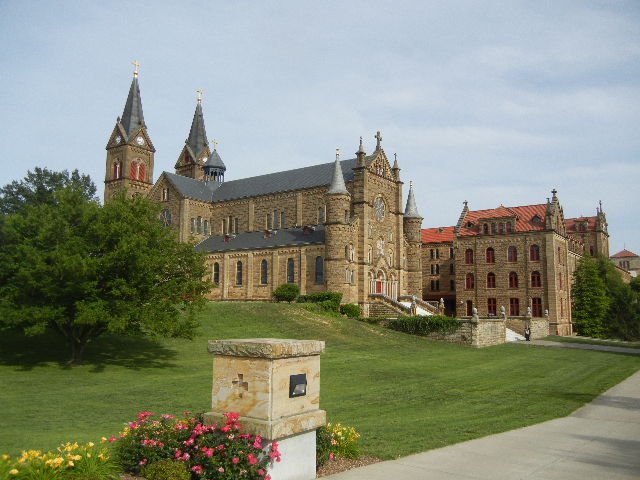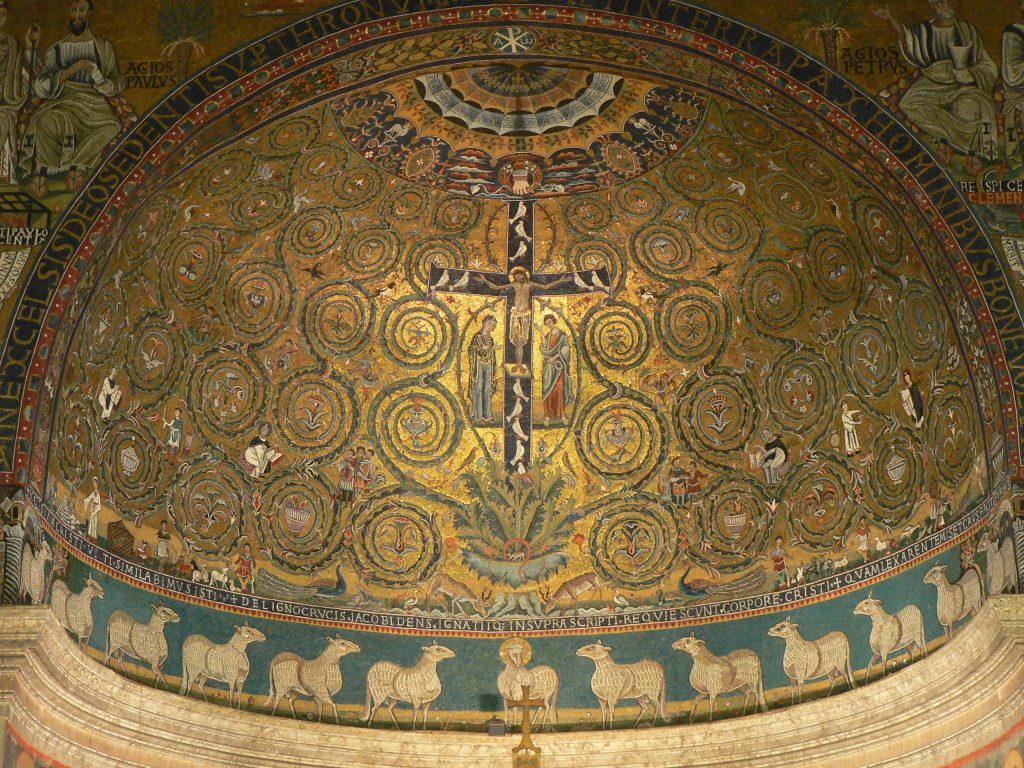 I have the privilege of celebrating this year’s commencement Masses at St. Meinrad Archabbey and Seminary with the graduates of their seminary and lay ecclesial degree programs. The Mass this evening was for the seminary students, and the morning will be with the lay degree program members.
I have the privilege of celebrating this year’s commencement Masses at St. Meinrad Archabbey and Seminary with the graduates of their seminary and lay ecclesial degree programs. The Mass this evening was for the seminary students, and the morning will be with the lay degree program members.
This mosaic as you will read in the homily below is not from St. Meinrad, but rather from San Clemente in Rome. It seems an appropriate tool for insight into the readings this week from John’s Gospel, Chapter 15.
St. Meinrad Commencement Masses
May 11 – 12
Thank you for the invitation to join the St. Meinrad Community for this year’s commencement celebrations. It is always a joy to be back in Southern Indiana, and particularly, to celebrate Mass with this community.
We gather this evening to celebrate a ‘landmark’ , namely, the completion of this particular track of theological studies, and for many of you, the launch of a new leg in your journey of faith. This week, the Church is hearing and reflecting on John’s Gospel and Jesus’ proclamation to be the Vine, to which we as ‘branches’ must remain firmly attached if our lives are to be fruitful.
 As a symbol of interpreting today’s readings, I wish to reflect with you upon a powerful mosaic in the apse of Saint Clement Church in Rome. This beautiful work of art has been a focus for my prayer in recent weeks; not so much by my own choosing, but by the grace of God.
As a symbol of interpreting today’s readings, I wish to reflect with you upon a powerful mosaic in the apse of Saint Clement Church in Rome. This beautiful work of art has been a focus for my prayer in recent weeks; not so much by my own choosing, but by the grace of God.
In the center of this mosaic is a depiction of the crucifixion, complete with the Blessed Mother and St. John standing at the foot of the cross. Above the cross, the Father’s hand is extending the crown of victory to the Son, now that the work of Redemption is accomplished. Sprouting from the base of the Tree of the Cross is a vine which spreads throughout the mosaic. This vine represents the Church, and recalls the words of Jesus: “I am the vine, you are the branches.” (John 15:5)
The beautiful presence of the vine spreading throughout the mosaic symbolizes the Redeeming work and presence of Jesus in the world, through the Church. Also at the base of the Cross is a font, which becomes a stream running along the base of the mosaic. Two stags are depicted drinking from this life-giving stream, recalling the words of Psalm 42:1: “As a deer longs for flowing streams, so my soul longs for you, O God.”
In the Gospel we have just heard this evening, Jesus tells his disciples to go and bear much fruit, fruit that will remain. (John 15:16) He also clarifies that the one thing that remains, the hallmark of His life within us that we are to share with others, is His love. This is the great new commandment: “Love one another, as I have loved you.” (John 15:12)
This mosaic demonstrates very clearly that life flows from the cross. The vine, the Church, flows from the Cross. Obviously, it is not just the cross, but the Son of God crucified upon the cross, who poured out His obedience to the Father in the fullest expression of love for the Father and for us in shedding his Life blood.
St. John in his Gospel makes a clear distinction regarding this word, ‘life.’ He speaks of bios which is the life of the body, the worldly life. Then, he speaks of zoe the fullness of life, the life shared by the Father and the Son. This is the life shed and shared from the cross that gives the fullness of life to all of creation and to every human person. This life of the crucified and Risen Lord is the life Jesus speaks of when he tells us: “I am the Way, the Truth, and the Life.” (John 14:6) This is the life the Christ freely laid down, and freely took up again, that we might have life and have it to the full. (see John 10:10, 18) This is the life of the Church; the Church that now calls each of you into service.
As this beautiful mosaic clearly shows life stemming from Christ, who is the Way, the Life, the Vine, it is a positive instruction that we must always remain rooted in Christ. These too are the words of Christ to the Church this week: “Remain in my love.” (John 15:9) Just as any living creature, plant or person withers and dies with a lack of water, so too, our faith and ministry loses vibrancy, loses credibility when it gets distant or cut off from Christ, distant or cut off from the Successor of Peter. Our life and ministry flow from the Paschal Mystery of Christ and to the degree our life and ministry draw others into this Mystery, we indeed are bearing the ‘fruit that remains.’
This Paschal Mystery, this ‘work of Christ’ restores the relationship of humanity with the Father. The lesson learned in this is that relationships are hard work! Maintaining unity in the Church also requires hard work, patience, perseverance, and the same trust in the Father demonstrated by the Son.
Pope Benedict insists in much of his preaching and writing that the fundamental question for the human person today is a question of God. This ‘act of faith’ in God and in Jesus Christ is what changes the life of a person. We see this ‘encounter’ which individuals have with Jesus over and over again in the Gospels, beginning with the call of his disciples and continuing with many others who are longing for truth, hope, healing, forgiveness, meaning and purpose.
These are the same fundamental things every human person longs and searches for, and they are ultimately found in Christ. If one’s faith is not at the heart and center of one’s person and identity, this ‘conversion’, this ‘fullness of life’ is not possible.
So, my dear friends, ‘stirring’ this fervent and active faith to life is at the heart of the Church’s mission and ministry today. For many today, including those who consider themselves ‘good Catholics’ faith is merely external; just customs and traditions, it lacks what is fundamental, namely, the living person of Jesus Christ.
Our Challenge today, your challenge today as you go forth from this ‘holy hill’ as leaders in the Church, particularly as catechists, teachers and preachers, is to help people first and most importantly to have this ‘encounter’ with the living Christ. Our role, your role, is to provide people not only with the basic tenants of the faith, but to raise these tenants of the faith to the level where it truly influences the life of each person.
Our challenge is to both personally live the faith and present the faith in a manner that leads others to the fullness of life in the Risen Christ.
The great challenge in our Church today is to help our people live with a strong coherence between faith and every aspect of life. Part of our task today is to help people formulate the answers to why they believe in Christ and to understand why they are Catholic. Fundamentally, religion, faith means to live in relationship with the Risen Christ.
In our readings this evening, we hear a clear and strong reference to how important it is for us to ‘remain in Christ’ as Church. The first line from the Acts of the Apostles this evening says: “The Apostles and presbyters, in agreement with the whole Church decided to choose representatives and to send them to Antioch with Paul and Barnabas.”
All of us who minister in the Church are to act in like manner – to act in communion with the Universal Church. All of us who minister in the Church are servants of unity. Christ’s gift of self on the cross tells us that to be at the service of unity will require great generosity on our part – and promises that our lives – in communion with Christ and His Church, will bear much fruit.
One final reference to our passage from the Acts of the Apostles this evening tells us that Paul and Barnabas “dedicated their lives to the name of Jesus Christ our Lord.” My dear friends, this is a great recommendation for each of us. Let us dedicate our lives to Jesus Christ. Let us place our lives in the hands of the Father – trusting in His Providential care; hoping and believing as we do so, that our lives will bear much fruit, for the good of the Church and the glory of God.
0